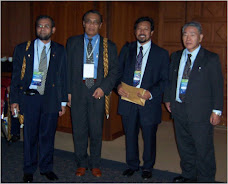World energy consumption is expected to increase 40% to 50% by the year 2010, and the global mix of fuels remains as; renewables (18%), nuclear (4%) and fossil (78%)
World energy consumption is projected to remain substantially the same as today, thus global carbon dioxide emissions would also increase 50% to 60%.
Fossil fuels are depleted at a rate that is 100,000 times faster than they are formed.
Worldwide, some 2 billion people are currently without electricity.
Developing countries use 30% of global energy. Rapid population growth, combined with economic growth, will rapidly increase that percentage in the next 10 years.
The World Bank estimates that investments of $1 trillion will be needed in this decade and upwards of $4 trillion during the next 30 years to meet developing countries' electricity needs alone.
According to Oil & Gas Journal (OGJ), Malaysia held proven oil reserves of 3.0 billion barrels as of January 2007, down from a peak of 4.6 billion barrels in 1996. The majority of the country’s oil reserves are located off the coast of peninsular Malaysia.
Approximately 30,000 lives are cut short in the U.S. each year due to pollution from electricity production. (ABT Associates study)
About 81 tons of mercury are emitted into the atmosphere each year as a result of electric power generation. Mercury is the most toxic heavy metal in existence. (U.S. Environmental Protection Agency)
Burning fossil fuels to produce energy releases carbon dioxide and other global-warming-causing gases into the atmosphere.
Global warming will increase the incidence of infectious diseases (including equine encephalitis and Lyme disease), death from heat waves, blizzards, and floods, and species loss. (Chivilan and Epstein, Boston Globe, April 10, 1997)
Human activities have caused a dramatic increase in the amount of carbon dioxide (CO2) in the earth's atmosphere. The main causes of increasing CO2 concentrations are the burning of fossil fuels — coal, petroleum products, natural gas — and deforestation.
Since about 1750, the concentration of CO2 has risen from about 280 parts per million by volume (ppmv) to reach 377 ppmv in 2004 — a value that has likely not been exceeded during the past 20 million years.
In 2000, CO2 emissions from fuel combustion have increased by approximately 10% compared with FY1990,
Carbon emissions in North America reached 1,760 million metric tons in 1998, a 38 % increase since 1970. They are expected to grow another 31 %, to 2,314 million metric tons, by the year 2020. (U.S. Department of Energy)
On average, 16 million tons of carbon dioxide are emitted into the atmosphere every 24 hours by human use worldwide.
1995 was the warmest year since global temperatures were first kept in 1856.
Emissions of carbon dioxide and other gases are causing global warming. (Chivilan and Epstein, Boston Globe)
The IPCC's Third Assessment Report (2001) concluded that if no explicit action is taken to curb GHG emissions from human activities, the global average surface temperature is projected to increase by 1.4 to 5.8°C between 1990 and 2100.
The global climate change is actually much more complicated than to a warmer summer, because a change in the temperature can cause changes in other weather elements such as clouds or precipitation.
































